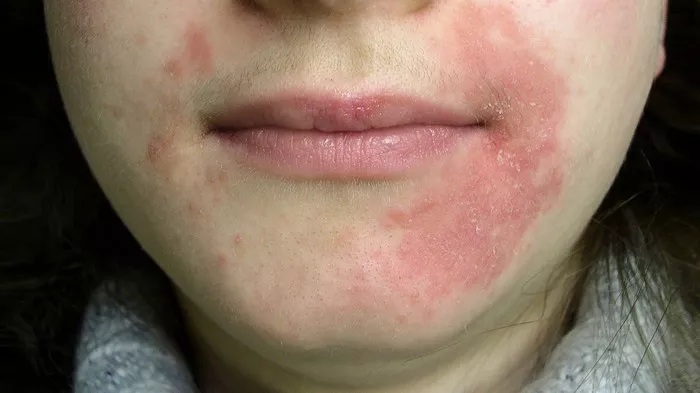Perioral dermatitis is a common skin condition characterized by small, red, and inflamed bumps that typically appear around the mouth, nose, and sometimes around the eyes. While it may resemble acne or rosacea, perioral dermatitis has distinct features and requires specific treatment approaches. Understanding the causes, symptoms, and available treatments is essential for managing this condition effectively.
Understanding Perioral Dermatitis
Perioral dermatitis primarily affects women between the ages of 15 and 45, although it can occur in men and children as well. Its exact cause is not fully understood, but several factors are believed to contribute to its development. These include:
1. Causes of Perioral Dermatitis
Topical Steroid Use: Prolonged use of topical steroids on the face, such as corticosteroid creams, can trigger perioral dermatitis. Steroids disrupt the skin’s natural balance, leading to inflammation and the development of skin eruptions.
Harsh Skincare Products: Certain skincare products containing ingredients like sodium lauryl sulfate, parabens, and fragrances can irritate the skin and contribute to the onset of perioral dermatitis.
Hormonal Changes: Fluctuations in hormone levels, such as those occurring during puberty, pregnancy, or while taking oral contraceptives, may play a role in the development of perioral dermatitis.
Microbial Factors: Bacterial or fungal overgrowth on the skin’s surface can exacerbate inflammation and contribute to the persistence of perioral dermatitis.
Environmental Factors: Exposure to harsh weather conditions, pollution, and UV radiation can irritate the skin and trigger flare-ups of perioral dermatitis.
Symptoms of Perioral Dermatitis
The characteristic symptoms of perioral dermatitis include:
1. Small, red bumps or papules around the mouth, nose, and eyes.
2. Itching or burning sensation in the affected area.
3. Dryness and flakiness of the skin.
4. Mild swelling and tenderness.
5. Occasionally, the bumps may ooze or crust over.
Diagnosis and Treatment
Diagnosing perioral dermatitis typically involves a visual examination by a dermatologist. In some cases, a skin biopsy may be performed to rule out other conditions with similar symptoms. Once diagnosed, treatment usually involves a combination of lifestyle changes, skincare adjustments, and medication.
1. Treatment Approaches
Avoidance of Triggering Factors: Identifying and avoiding factors that exacerbate perioral dermatitis is crucial for managing the condition. This includes discontinuing the use of topical steroids, switching to gentle skincare products, and minimizing exposure to environmental irritants.
Topical Treatments: Topical antibiotics such as metronidazole or erythromycin are commonly prescribed to reduce inflammation and control bacterial growth. Non-steroidal anti-inflammatory creams may also help alleviate symptoms.
Oral Medications: In severe cases or when topical treatments fail to provide relief, oral antibiotics like doxycycline or tetracycline may be prescribed. These medications target the underlying bacterial or inflammatory processes contributing to perioral dermatitis.
Steroid Withdrawal: Gradually tapering off the use of topical steroids under medical supervision is essential for preventing rebound flare-ups of perioral dermatitis.
Moisturizers and Sunscreen: Using gentle, non-comedogenic moisturizers and broad-spectrum sunscreen can help protect the skin and prevent further irritation.
Probiotics: Some studies suggest that oral probiotics may help restore the skin’s natural microbiome and reduce inflammation in individuals with perioral dermatitis.
Home Remedies and Self-Care Tips
While medical treatment is essential for managing perioral dermatitis, several home remedies and self-care tips can complement professional therapy:
Gentle Cleansing: Wash the affected area with a mild, non-soap cleanser and lukewarm water twice daily to remove dirt and oil without aggravating the skin.
Avoidance of Irritants: Steer clear of harsh skincare products, including scrubs, astringents, and alcohol-based toners, which can worsen inflammation.
Hydration: Keep the skin hydrated by applying a fragrance-free moisturizer regularly, especially after cleansing or showering.
Stress Management: Stress can exacerbate skin conditions like perioral dermatitis. Engage in stress-reducing activities such as yoga, meditation, or deep breathing exercises.
Healthy Diet: Maintain a balanced diet rich in fruits, vegetables, whole grains, and lean proteins. Avoid spicy foods, caffeine, and alcohol, which may trigger flare-ups.
Conclusion
Perioral dermatitis can be a frustrating and uncomfortable condition, but with proper diagnosis and treatment, most individuals can effectively manage their symptoms and prevent recurrences. Identifying and avoiding triggering factors, adopting a gentle skincare routine, and seeking medical advice when necessary are key steps in achieving clear and healthy skin. By understanding the causes, symptoms, and treatment options for perioral dermatitis, individuals can take control of their skincare and enjoy improved quality of life. If you suspect you may have perioral dermatitis or are struggling to manage your symptoms, consult a dermatologist for personalized evaluation and guidance.
[inline_related_posts title=”You Might Be Interested In” title_align=”left” style=”list” number=”6″ align=”none” ids=”1396,1303,1295″ by=”categories” orderby=”rand” order=”DESC” hide_thumb=”no” thumb_right=”no” views=”no” date=”yes” grid_columns=”2″ post_type=”” tax=””]























